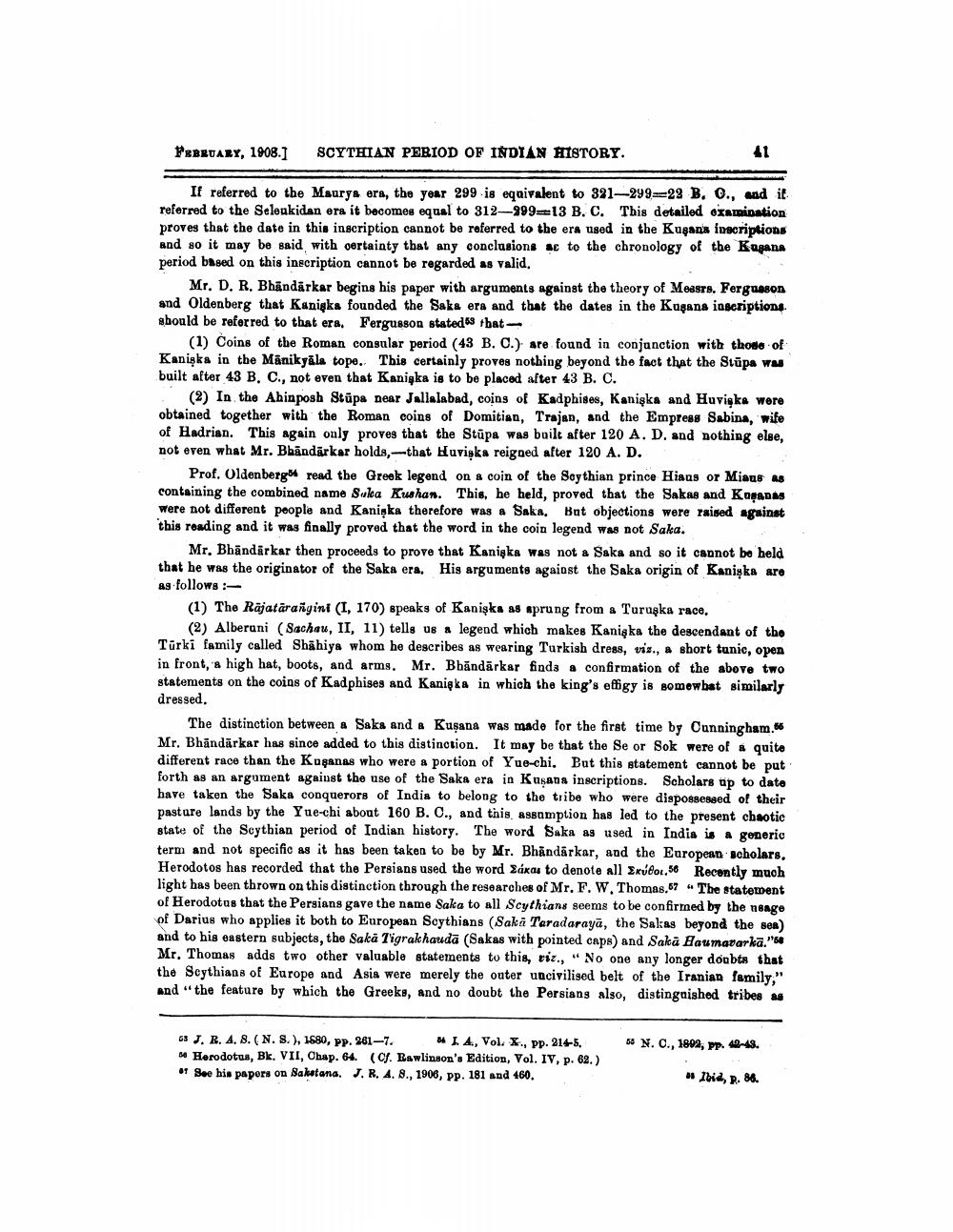________________
FEBRUARY, 1908.)
SCYTHIAN PERIOD OF INDIAN HISTORY.
If referred to the Maurya era, the year 299 is equivalent to 321-299=22 B, 0., and it referred to the Seleukidan era it becomes equal to 312-999.13 B. C. This detailed examination proves that the date in this inscription cannot be referred to the era used in the Kuşans inscriptions and so it may be said with oertainty that any conclusions as to the chronology of the Kapana period based on this inscription cannot be regarded as valid.
Mr. D. R. Bhandarkar begins his paper with arguments against the theory of Messrs. Ferguson and Oldenberg that Kanigka founded the Saks era and that the dates in the Kuşans inscriptions should be referred to that era. Fergusson stated that
(1) Coins of the Roman consular period (43 B. C.) are found in conjunction with those of Kanişka in the Manikyala tope. This certainly proves nothing beyond the fact that the Stūpa was built after 43 B, C., not even that Kaniqka is to be placed after 43 B. C.
(2) In the Ahinposh Stūpa Dear Jallalabad, coins of Kadphises, Kanigka and Huvi ka were obtained together with the Roman coins of Domitian, Trajan, and the Empress Sabina, wife of Hadrian. This again only proves that the Stūpa was built after 120 A. D. and nothing else, not even what Mr. Bhändārkar holds, ---that Huviska reigoed after 120 A. D.
Prof. Oldenbergo read the Greek legend on a coin of the Soythian prince Hiaus or Miaus as containing the combined name Suka Kushan. This, he held, proved that the Sakas and KONADAS were not different people and Kaniqka therefore was a Saka. But objections were raised against this roading and it was finally proved that the word in the coin legend was not Saka.
Mr. Bhändärkar then proceeds to prove that Kanigks was not a Saka and so it cannot be held that he was the originator of the Saks era. His arguments agaiost the Saka origin of Kanižka sro as follows:
(1) The Rājatārañyini (I, 170) speaks of Kaniska as aprung from a Turuska race.
(2) Alberani (Sachau, II, 11) tells us a legend which makes Kaniaka the descendant of the Türki family called Shāhiya whom he describes as wearing Turkish dress, viz., a short tonic, open in front, a high hat, boots, and arms. Mr. Bhăndārkar finds a confirmation of the above two statements on the coins of Kadphises and Kanişka in which the king's effigy is somewbat similarly dressed.
The distinction between a Saka and a Kuşana was made for the first time by Cunningham. Mr. Bhändārkar has since added to this distinction. It may be that the Se or Sok were of a quite different race than the Kuşanas who were a portion of Yue-chi. But this statement cannot be put forth as an argument against the use of the Saka era in Kusana inscriptions. Scholars up to date have taken the Saka conquerors of India to belong to the tribe who were dispossessed of their pastare lands by the Yue-chi about 160 B. O., and this assumption has led to the present chaotic state of the Scythian period of Indian history. The word Saka as used in India is A gonorio term and not specific as it has been taken to be by Mr. Bhandarkar, and the European scholars. Herodotos has recorded that the Persians used the word akas to denote all kýbor, 56 Recently much light has been thrown on this distinction through the researches of Mr. F. W. Thomas.57 - The statement of Herodotus that the Persians gave the name Saka to all Scythians seems to be confirmed by the nsage of Darius who applies it both to European Scythians (Saka Taradaraya, the Sakas beyond the sea) and to his eastern subjects, the Saka Tigrak haudā (Sakas with pointed caps) and Saka Baumadarka." Mr. Thomas adds two other valuable statements to this, viz., " No one any longer doubts that the Scythians of Europe and Asia were merely the outer uncivilised belt of the Iranian family," and the feature by which the Greeks, and no doubt the Persians also, distinguished tribes as
56 N. O., 1892, PP. 42-43.
63 J. R. A. 8. (N. S.), 1880, pp. 261—7. ML 4., Vol. X., pp. 214-5. 16 Herodotus, Bk. VII, Chap. 64. (Cf. Rawlinson's Edition, Vol. IV, p. 62.)
See his papors on Saksana. J.R. A. 8., 1906, pp. 181 and 160.
*Ibid, R. 86.




